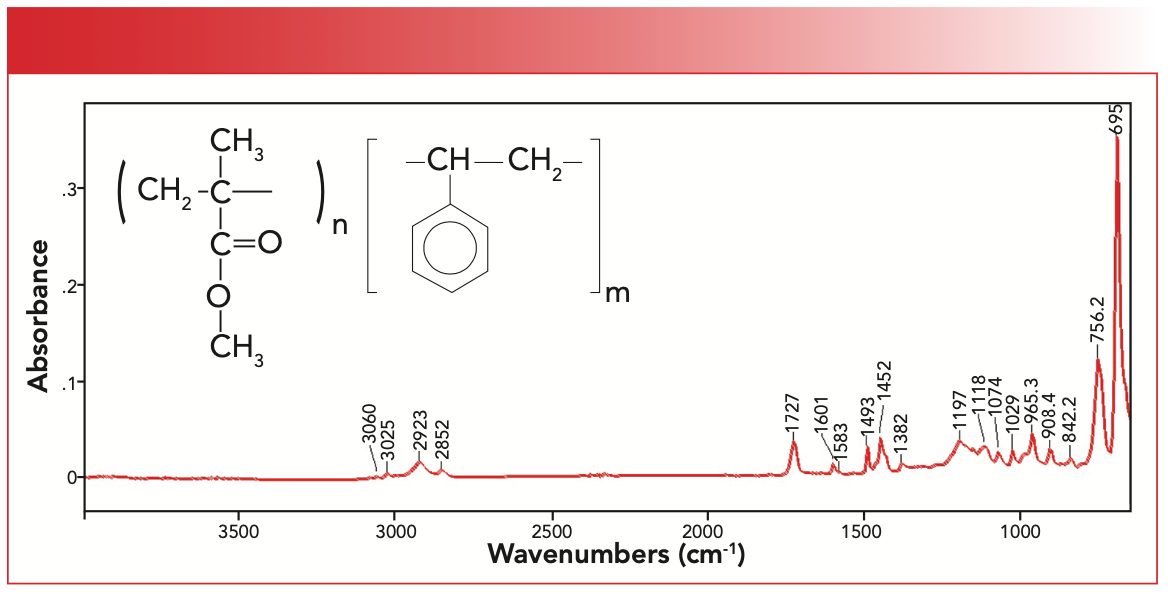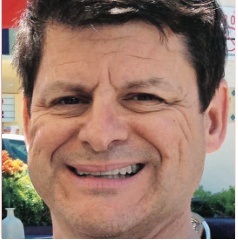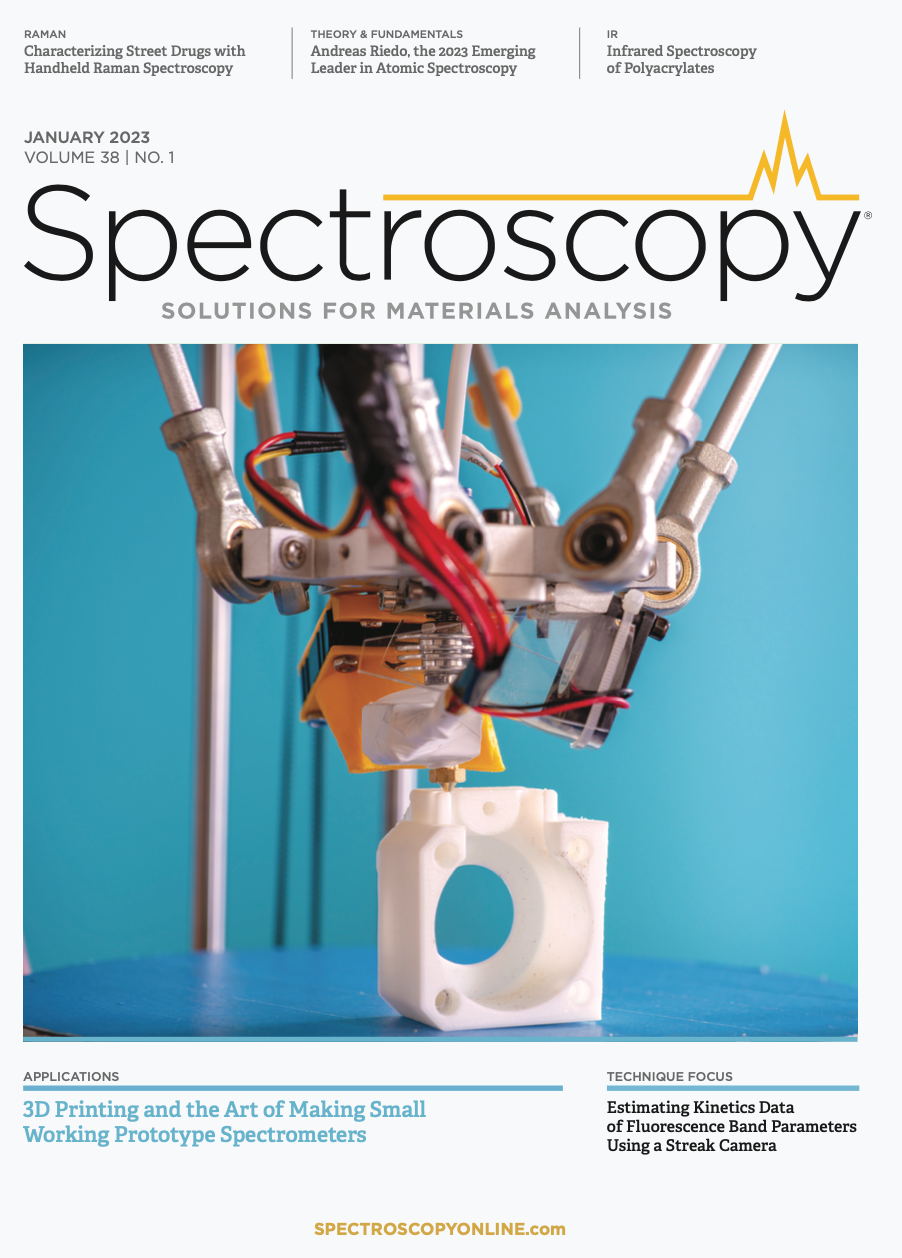Infrared Spectroscopy of Polymers X: Polyacrylates
Acrylate polymers are derivatives of acrylic acid, but contain a plethora of different functional groups and are best discussed by themselves. In this column, we study the spectrum of an important polymer, polymethyl methacrylate (PMMA), which is otherwise known as plexiglass, and is found in windows, car parts, and paint. We then study the spectra of PMMA mixtures and copolymers in detail.
We have studied esters (1) and polyesters (2,3) in the past. We discuss the spectroscopy of the ester functional group in this article, amongst others. Thus, I briefly reintroduce you to the structure and spectroscopy of esters.
Esters are characterized by C=O, C-C-O, and O-C-C linkages, and are divided into the families of saturated or aromatic esters depending upon the nature of the carbon attached to the carbonyl carbon. Ester infrared (IR) spectra follow the Rule of Three (1). This means they have three big peaks at approximately 1700, 1200, and 1100 cm-1 (going forward all peak positions will be in cm-1 units even if not so noted). These correspond to the stretching of the C=O, C-C-O, and O-C-C units. Table I summarizes the Rule of Three group wavenumbers for esters.

It All Begins with Acrylic Acid
The family of acrylate polymers is based on the parent molecule acrylic acid, whose structure is seen in Figure 1.
FIGURE 1: The chemical structure of acrylic acid.

Note that acrylic acid contains a vinyl C=C bond, and a carboxylic acid, functional groups whose structures and spectra we have studied in the past (4,5). The IR spectrum of acrylic acid is seen in Figure 2.
FIGURE 2: The chemical structure and IR spectrum of acrylic acid.

Recall (5) that any peak associated with the O-H bond in a carboxylic acid is broadened because of hydrogen bonding. Thus, the broad O-H stretching envelope seen in Figure 2 extends from approximately 3800 to 2000, and the bottom of the O-H wagging envelope is at approximately 930. Carboxylic acids also have strong C=O and C-O stretching peaks, which fall at 1702 and 1248 in Figure 2. The C=O stretch for acrylic acid falls below that for saturated acids, because the carbonyl group conjugates with the C=C bond, similar to how aromatic rings conjugate to C=O bonds (6).
The vinyl group in acrylic acid can be reacted to form a polymer, like many other vinyl containing monomers (4). Polymers made from acrylic acid derivatives are called polyacrylates. There are many different functional groups that can be attached to the acrylic acid frame, including esters, which is the focus of this column.
Polyacrylates
Polymethyl Methacrylate (PMMA)
Perhaps the most common polyacrylate is polymethyl methacrylate, or PMMA. This polymer is economically important, and trade names for it include PlexiGlass and Lucite (7). Because PMMA is transparent, it can be used in place of traditional glass in uses such as windows, doors, and aquariums. The IR spectrum and structure of PMMA are seen in Figure 3.
FIGURE 3: The structure and IR spectrum of polymethyl methacrylate (PMMA).

Note that there is a pendant ester group and two CH3 groups in PMMA. The first methyl in the name denotes the CH3 in the ester group. The term methacrylate refers to the fact that the acrylic acid monomer has a methyl group attached to the C=C bond. The major peaks in this spectrum are, not surprisingly, the Rule of Three peaks from the ester (1). Specifically, the C=O stretch is labeled A at 1730 cm-1, the C-C-O stretch at 1191 cm-1, and the O-C-C stretch is at 1149 cm-1, and they are labeled together as B in Figure 3. Unfortunately, PMMA does not strictly follow the Rule of Three peaks for saturated esters listed in Table I. The C=O stretch is 5 cm-1 too low, the C-C-O stretch is in the right place at 1191, but there is no O-C-C stretch between 1100 and 1030. There is an intense peak at 1149, which, for lack of a better assignment, I will call the ester O-C-C stretch. I have no idea why PMMA does not follow the rules for esters. As I have said in the past, all the peak position ranges I give you have exceptions, which is why there are few absolutes in IR spectral interpretation.
Polystyrene/PMMA Copolymers
Copolymers of polystyrene and PMMA are common materials as they are also clear and rigid. Uses of these materials include as food containers, drinkware, and as additives to things like cement and concrete. A common name for these copolymers is styrene methyl methacrylate (SMMA). The structure and IR spectrum of SMMA are seen in Figure 4.
FIGURE 4: The structure and IR spectrum of polystyrene methyl methacrylate (SMMA).

Note that the structure of SMMA is a mixed molecule containing both saturated and unsaturated carbons. Hence, there are C-H stretches above and below 3000 (8). The styrene portion of the polymer contains a monosubstituted benzene ring, and as we have seen before (9) these have an aromatic C-H wag from 770–710, and an aromatic ring bend at 690±10. The monosubstituted benzene ring in SMMA exhibits these peaks at 757 and 695, respectively. The ring modes of the benzene ring in styrene, due to the stretching of the carbon-carbon bonds in the ring, are at 1601 and 1583. Recall (8) that these peaks are always sharp, are used to distinguish between C=C and aromatic carbon-carbon bonds, but vary in number and intensity depending upon the molecule.
The methacrylate ester part of SMMA will have three peaks because it is an ester (1). In Figure 4, the C=O stretch is at 1727, the C-C-O stretch is at 1197, and the O-C-C stretch is at 1074. These Rule of Three peaks are not as big as we are used to seeing, because the PMMA units in SMMA are diluted by the presence of polystyrene.
Figure 5 shows a comparison of the spectra of pure polystyrene and a polystyrene/PMMA copolymer. Note that the monosubstituted benzene ring peaks in the two spectra line up quite nicely, with the C-H stretches at 3060 and 3025, the ring mode at 1601, C-H wag at 756, and the aromatic ring bend at 698 in both spectra. The point here is that, even though polystyrene/PMMA copolymers have two repeat units in the same backbone, their spectra look like a simple mixture of the two. This indicates there is very little chemical interaction between the different repeat units in the polymer.
FIGURE 5: A comparison of the spectrum of pure polystyrene and a polystyrene-methyl methacrylate copolymer.

Polyethyl Methacrylate
A molecule similar to PMMA is polyethyl methacrylate (PEMA), where the CH3 group attached to the chain in PMMA is replaced by an ethyl (CH3-CH2-) group. This material is softer than PMMA, and is used to make artificial fingernails amongst other things (10). The structure and IR spectrum of PEMA are seen in Figure 6.
FIGURE 6: The chemical structure and IR spectrum of polyethyl methacrylate (PEMA).

Because PEMA has both methyl and methylene groups, there are three saturated C-H stretching peaks between 3000 and 2850 (11). However, this spectrum is dominated by the Rule of Three peaks for the ester present, with the C=O stretch at 1728, the C-C-O stretch at 1147, and the O-C-C stretch at 1064.
These three peaks in PMMA fall at 1730 cm-1, 1191 cm-1, and 1149 cm-1, respectively. Thus, the spectra of these two materials are similar, but not identical.
Conclusions
In this article, we have studied the structure and spectra of acrylate polymers. The name for the class comes from acrylic acid. We saw that the spectrum of acrylic acid has peaks from the C=C and -COOH functional groups. Polymers made from acrylic acid monomers often times contain pendant ester groups. We covered the structure and spectrum of the economically important molecule polymethyl methacrylate, its copolymer with polystyrene, and its related molecule polyethyl methacrylate. Their spectra were dominated by the Rule of Three peaks from the esters present.
References
(1) Smith, B.C. The C=O Bond, Part VI: Esters and the Rule of Three. Spectroscopy 2018, 33(7), 20–23.
(2) Smith, B.C. Infrared Spectroscopy of Polymers, VIII: Polyesters and the Rule of Three. Spectroscopy 2022, 37(10), 25–28. DOI: 10.56530/spectroscopy.ta9383e3
(3) Smith, B.C. Infrared Spectroscopy of Polymers, IX: Pendant Ester Polymers and Polycarbonates. Spectroscopy 2022, 37(11), 16–19, 31. DOI: 10.56530/spectroscopy.xn9369p8
(4) Smith, B.C. The Infrared Spectroscopy of Alkenes. Spectroscopy 2016, 31(11), 28–34.
(5) Smith, B.C. The C=O Bond, Part III: Carboxylic Acids. Spectroscopy 2018, 33(1), 14–20.
(6) Smith, B.C. The Carbonyl Group, Part I: Introduction. Spectroscopy 2017, 32(9), 31–36.
(7) https://en.wikipedia.org/wiki/Poly(methyl_methacrylate)
(8) Smith, B.C. Group Wavenumbers and an Introduction to the Spectroscopy of Benzene Rings. Spectroscopy 2016, 31(3), 34–37.
(9) Smith, B.C. Distinguishing Structural Isomers: Mono- and Disubstituted Benzene Rings. Spectroscopy 2016, 31(5), 36–39.
(10) https://en.wikipedia.org/wiki/Poly(ethyl_methacrylate)
(11) Smith, B.C. More Theory and Practice: The Thorny Problem of Mixtures and More on Straight Chain Alkanes. Spectroscopy 2015, 30(7), 28.
Brian C. Smith, PhD, is the founder and CEO of Big Sur Scientific, a maker of portable mid-infrared cannabis analyzers. He has over 30 years experience as an industrial infrared spectroscopist, has published numerous peer-reviewed papers, and has written three books on spectroscopy. As a trainer, he has helped thousands of people around the world improve their infrared analyses. In addition to writing for Spectroscopy, Dr. Smith writes a regular column for its sister publication Cannabis Science and Technology and sits on its editorial board. He earned his PhD in physical chemistry from Dartmouth College. He can be reached at: SpectroscopyEdit@MMHGroup.com ●


AI Shakes Up Spectroscopy as New Tools Reveal the Secret Life of Molecules
April 14th 2025A leading-edge review led by researchers at Oak Ridge National Laboratory and MIT explores how artificial intelligence is revolutionizing the study of molecular vibrations and phonon dynamics. From infrared and Raman spectroscopy to neutron and X-ray scattering, AI is transforming how scientists interpret vibrational spectra and predict material behaviors.
Real-Time Battery Health Tracking Using Fiber-Optic Sensors
April 9th 2025A new study by researchers from Palo Alto Research Center (PARC, a Xerox Company) and LG Chem Power presents a novel method for real-time battery monitoring using embedded fiber-optic sensors. This approach enhances state-of-charge (SOC) and state-of-health (SOH) estimations, potentially improving the efficiency and lifespan of lithium-ion batteries in electric vehicles (xEVs).
New Study Provides Insights into Chiral Smectic Phases
March 31st 2025Researchers from the Institute of Nuclear Physics Polish Academy of Sciences have unveiled new insights into the molecular arrangement of the 7HH6 compound’s smectic phases using X-ray diffraction (XRD) and infrared (IR) spectroscopy.